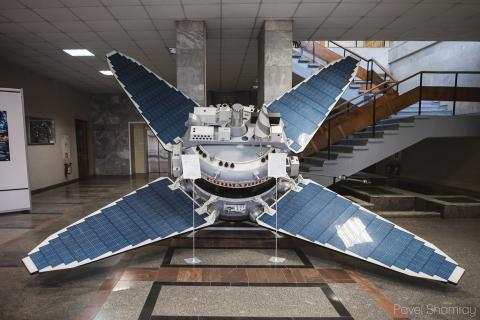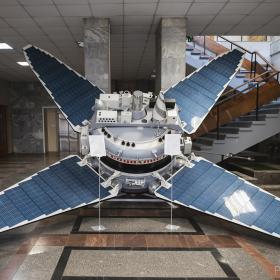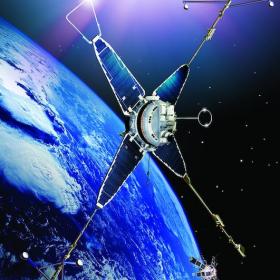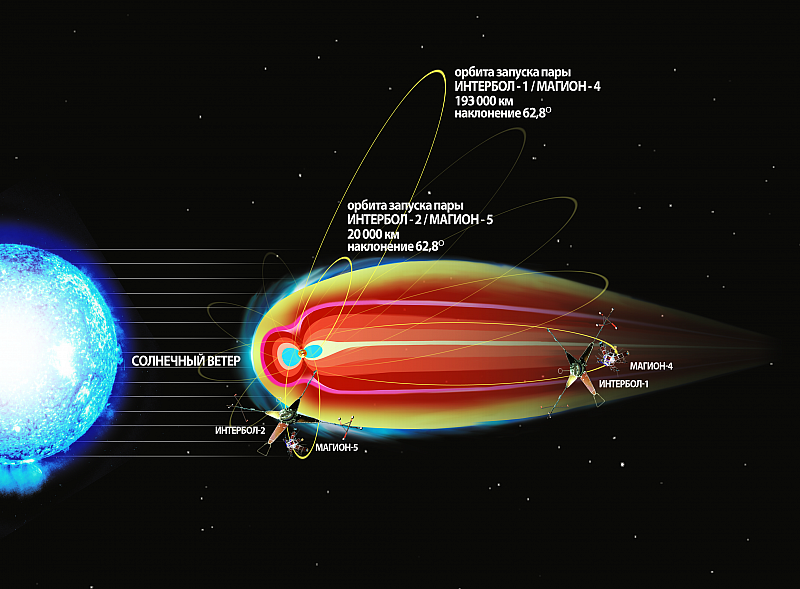
INTERBALL is a program to study solar-terrestrial relations and their influence on various plasma processes in the Earth's magnetosphere and the solar wind flowing around it.
The mission consisted of two pairs of spacecraft (satellite-subsatellite) orbiting in the polar region (auroral probe) and in the tail of the magnetosphere (tail probe), respectively. Each pair included a Prognoz satellite and a smaller Magion subsatellite. This provided the opportunity to observe plasma processes in different regions of the Earth's magnetosphere and the solar wind simultaneously. In fact, the INTERBALL project was the first real multi-satellite project in the history of space exploration.
The scientific instrumentation was created as part of an extensive scientific cooperation involving scientific institutes from 17 countries. The INTERBALL project was part of the International Research Program on Solar-Terrestrial Physics, including not only satellite projects, but also ground-based observations. The international cooperation was coordinated by the Inter-Agency Consultative Group (IACG), formed by the four major space agencies: RSA, ESA, NASA, ISAS.
Scientific Goals
Studies of plasma processes in key research areas such as the plasma and current-carrying tail layer of the Earth's magnetosphere, the boundary layer, and the solar wind flowing around it.
Mission Overview
The first pair of INTERBALL Project satellites, called the Tail Probe (Interball-1 and Magion-4 subsatellite), was launched on August 3, 1995, and entered the atmosphere in October 2000, while in operating order. The second pair, Auroral Probe satellites (Interball-2 and Magion-5 subsatellite) was launched on August 29, 1996 and orbited for 2.5 years. In a short time after the launch, the sub-satellites separated from their respective satellites and followed them at a distance of several thousand kilometers.
The Auroral Probe had an orbit with an apogee of 20,000 km with an inclination of 62.8 degrees, what allowed to study the main areas of the auroral and the cusp regions. The Tail Probe had an orbit with an apogee of 200,000 km and the same inclination, which enabled research of the main areas of energy release and plasma acceleration in the tail of the Earth's magnetosphere, as well as plasma processes in the solar wind.
The highlight of the INTERBALL project was the ability to simultaneously observe plasma processes occurring in different regions of the Earth's magnetosphere and in the solar wind, so that the cause-effect relationships in the magnetosphere-ionosphere interaction, as well as in the solar wind-magnetosphere interaction, could be investigated. In fact, the Interball project was the first real multi-satellite project in the history of space research.
The main scientific objectives of the Tail Probe were studies of plasma processes in key research areas such as the plasma and current-carrying tail layer of the Earth's magnetosphere, the boundary layer, and the solar wind flowing around it.
The orbit of the Tail Probe let it stay in the plasma and current layer for a long time. This had provided a large statistics of observations of such relevant processes for modern space physics as thinning of the current-carrying layer before a substorm, research of properties of accelerated plasma beams and flows, which gives remote information about sources of their acceleration, including magnetic reconnection occurring in more distant regions of the tail.
At the same time the Auroral Probe carried out observations of conjugated plasma phenomena in the auroral region. There were the first observations to study the auroral response of energy release and plasma particles acceleration in the geomagnetic tail and they were of great importance for understanding the processes of magnetosphere-ionosphere interaction.
At another stage of the project, when the orbits of the Tail Probe and the Auroral Probe crossed the regions of the daytime magnetosphere and ionosphere, the main tasks became simultaneous studies by the Tail Probe of various solar wind disturbances coming to the Earth after powerful solar flares and their influence on the structure of the cusp-cleft region and on the plasma processes in the daytime ionosphere observed by the Auroral Probe. The results obtained by such observations have made a significant contribution to the understanding of the causal relationships between the solar wind and the inner magnetosphere and ionosphere.
The solution of the above problems was of great significance for understanding the processes responsible for the entry of solar wind energy into the Earth's magnetosphere, its accumulation and release in the tail of the magnetosphere, and the influence of such energy release on the near-Earth regions of space and geomagnetic activity.
Similar processes exist in magnetospheres of other planets of the Solar System and, most probably, they can occur in envelopes of pulsars and other astrophysical objects. They cannot be reproduced in any ground-based plasma laboratory, and direct observations can be carried out only by satellite experiments in outer space.
The INTERBALL project instrumentation
Tail Probe
Energetic particles and X-rays
- DOC-2 Measurements of energy spectra and angular distributions of electron flux at energies of 15-400 keV and protons at energies, Ee = 10-400 keV, 20-1000 keV
- RF-15-1 Measurements of solar X-ray flux spectra and variations in the 2-240 keV range and solar flare imaging in the 2-8 keV range
- SKA-2 Measurements of ion composition and fluxes in the range of 0.05-150 keV and electron fluxes in the 40-200 keV range
- SOSNA-2 Dosimetric measurements
- RKI-2 Measurements of solar ionizing radiation at energies of 5, 15, 40, 100, 500 MeV and UV
Thermal plasma measurements
- SKA-1 Measurements of three-dimensional ion distribution function in the range 0.1-5 keV/nucleon. Measurements of energy spectra of ions of different masses with M = 1, 2, 4, 16 in the energy range 5-40 keV/nucleon in the antisolar direction
- VDP Ultra fast measurements of ion and electron integral fluxes using Faraday cylinders
- ELECTRON Measurement of three dimensional electron distribution functions in the energy range 0.01-26 keV
- CORALL Measurement of three dimensional ion distribution functions in the energy range, E = 0.05-25 keV
- AMEI-2 Measurement of the energy spectra of H+, He+, He++, O+ ions and heavier ions in the energy range 0.1-8 keV/nucleon
- MONITOR-3 Measurements of solar wind proton and alpha particle fluxes near the direction of the Sun with high temporal resolution
- PROMICS-3 Measurements of mass composition and three dimensional distribution functions of ion plasma components for the M=1-32 range and in the 0.001-30 keV/nucleon energy range
Magnetic and electric fields and waves
- FM-31 Measurements of three magnetic field components in the +/-0.2-200 nT and +/-0.-51000 nT ranges with 0.1 nT resolution
- ASPI Measurement and analysis of plasma wave spectra and instabilities in the range of 0-250 kHz:
- MIF-M Measurement of DC and AC magnetic fields
- OPERA Measurement of DC and AC electric field
- ADS Calculation of electric and magnetic field signal spectra
- IFPE Measurement of alternating fluxes of ions and electrons
- PRAM Processing of waveforms of measured magnetic field signals and plasma flows
- AKR-X Study of auroral kilometer radiation in the frequency range 100 kHz-1.5 MHz
Service systems
- SSNI (System for collection of scientific information) Data acquisition from scientific instruments, formation of a telemetry frame, recording of information to a hard disk (ZI mode) with further reading (VP mode), or direct TMI to the Earth. Storage capacity up to 160 MBytes (80 MBytes per one disk). Transfer rate 16-250 kbps (depending on mode).
- BNK, BNTS, BNTR, BNS Switching control and satellite orientation linking units
Auroral Probe
Energetic particles
- SKA-3 Measurement of electron and ion spectra in the energy range 0.03-15 keV; measurements of electron and ion anisotropy (M=1, 4, 16) in the energy range 30-500 keV/nucleon
- DOK-2 Measurements of energy spectra and angular distributions of electron flux at energies of 15-400 keV and protons at energies of 20-1000 keV
- 10K-80 Integral spectrometer for energetic protons at energies of 20-200 MeV
- RD-1M Radiation flux meter
Measurements of hot plasma
- ION Measurement of anisotropy and ion spectra (M = 1, 2, 4, 16) in the energy range 0.005-20 keV
- PROMICS-3 Measurements of ion composition (M = 1-32) and three dimensional distribution functions in the energy range 0.01-30 keV
Thermal plasma measurements
- HYPERBOLOID Measurements of ion composition (M = 1-32) and three dimensional distribution functions in the energy range 0.1-80 eV
- KM-7 Measurement of background plasma electron temperature in the range up to 10 eV
- ALPHA-3 Thermal plasma flux measurement (ion trap) for densities more than 1cm-3 and energies < 25 eV/Q
- RON Ion emitter, current I = 1-10 µA
Magnetic and electric fields and waves
- IMAP-3 Measurements of the three magnetic field components in the range of +/- 70,000 nT (1 nT resolution)
- IESP-2M Measurement of DC electric field strength and ultra-low frequency waves in the frequency range of 0-30 Hz
- NVK-ONCH Measurement of low frequency electromagnetic waves within the frequency range of 20 Hz to 20 kHz
- POLRAD Measurement of auroral kilometer radiation in the frequency range 20 kHz - 2 MHz
- MEMO Analyser of electromagnetic radiation in the frequency range 1 Hz - 240 kHz
Optical Observations
- UVAI Ultraviolet auroral imager in the 140-160 nm range
- UFSIPS Measurements of auroral oxygen emissions in the UV range at wavelengths of 130.4, 135.6, 149.3 nm
Technology experiments
- ANOD Control of solar panels degradation
Service systems
- SSNI (System for collection of scientific information) Data acquisition from scientific instruments, formation of a telemetry frame, recording of information to a hard disk (ZI mode) with further reading (VP mode), or direct TMI to the Earth. Storage capacity up to 160 MBytes (80 MBytes per one disk). Transfer rate 16-250 kbps (depending on mode).
- BNK, BNTS, BNTR, BNS Switching control and satellite orientation linking units
Mission Results
1. The joint observations of the Tail Probe and Japanese Geotail satellites in the tail of the Earth's magnetosphere allowed observing simultaneously for the first time the oppositely directed accelerated plasma jets moving in the plasma layer from the magnetic reconnection region and obtaining information on its localization in the current-carrying layer of the tail.
2. With the Tail Probe satellite observations, for the first time the vertical component of the magnetospheric convection velocity was measured, and found its averaging about 10 km/s during periods of the south direction of the interplanetary magnetic field (IMF) and decreasing to almost zero during the north direction of the IMF.
3. With the help of the Tail Probe satellite, the first experimental confirmation of the presence of resonant nonadiabatic ion acceleration in spatially localized sources located in the far regions of the tail current-carrying layer was obtained and it was shown that such acceleration occurs almost continuously.
4. Due to the uniquely high energy resolution of the DOK-2 spectrometers on the Tail Probe, for the first time the acceleration of nearly monoenergetic ion beams of pritons, alpha particles, and heavy ions from the CNO group was observed, both in the Earth's magnetosphere tail and on the day side near the bow shock front. Such ion beams can be accelerated by high-amplitude bursts of the electric field during the collapse of current filaments during unsteady magnetic reconnection.
5. As part of the INTERBALL project the first ionospheric scanning experiment was carried out. The experiment was realized with the help of the Auroral Probe and the Norwegian heating stand EISCAT. The heating stand emitted radio waves into the ionosphere, with a power sufficient to modify the characteristics of the magnetosphere-ionosphere interaction system. During the experiment, the Auroral Probe was near the midnight meridian at an altitude of ~ 8000 km, i.e. much higher than the ionosphere, which allowed it to register an upward flow of electrons, generating a longitudinal electric current flowing into the ionosphere and linking the heating region in the ionosphere with some region in the magnetospheric tail. This experiment provided the first direct observation of artificial generation of longitudinal electric current, similar to the current appearing during magnetic substorms.
Leading Organizations and Principal Investigators
- Space Research Institute of the Russian Academy of Sciences (IKI): lead organization for the scientific payload
In Collaboration With
Scientific instruments installed on INTERBALL satellites were developed within the framework of a broad scientific cooperation that included scientific institutes of Austria, Bulgaria, Canada, Czech Republic, Finland, France, Germany, Hungary, Italy, Kyrgyzstan, Poland, Romania, Slovakia, Sweden, United Kingdom, Cuba, and Ukraine.
INTERBALL project became part of the International Solar-Terrestrial Physics (ISTP) research program and took its rightful place in the unique "constellation" of satellites operating at that time in orbit: Wind (NASA), Polar (NASA), SOHO (ESA), Geotail (JAXA) and many others launched from 1992 to 2000. Along with satellite observations under this program, ground-based measurements were realized at a network of stations located at different latitudes and longitudes around the globe. The international cooperation was coordinated by the Inter-Agency Consultative Group (IACG), formed by four major space agencies: RSA, ESA, NASA, ISAS.
Main Mission Publications
More than 500 scientific articles have been published based on data obtained by the Interball satellites, most of papers were written as part of international scientific collaboration. Such as for instance, special issues of journals like: Annales Geophysicae (1997, Vol.15, 5; 1998, Vol.16, 9; 2002, Vol.20, 3); Cosmic Research (#1, 3, 6, 1998; #6, 1999; #5, 2000; #4, 2002) and conference proceedings.
A complete list of scientific papers done as part of the Interball project is available at http://iki.cosmos.ru/interball.
Gallery





